Shifting Income Sources of the Aged
Social Security Bulletin, Vol. 72, No. 3, 2012 (released August 2012)
Traditional defined benefit pensions, once a major source of retirement income, are increasingly giving way to tax-qualified defined contribution (DC) plans and individual retirement accounts (IRAs). This trend is likely to continue among future retirees who have worked in the private sector. This article discusses the implications of those trends for the measurement of retirement income. We conclude that Census Bureau's Current Population Survey (CPS), one of the primary sources of income data, greatly underreports distributions from DC plans and IRAs, posing an increasing problem for measuring retirement income in the future. The CPS and other data sources need to revise their measures of retirement income to account for periodic (irregular) distributions from DC plans and IRAs.
Chris Anguelov and Patrick Purcell are with the Division of Policy Evaluation, Office of Research, Evaluation, and Statistics (ORES), Office of Retirement and Disability Policy (ORDP), Social Security Administration (SSA). Howard Iams is a senior research advisor to ORES, ORDP, SSA.
Contents of this publication are not copyrighted; any items may be reprinted, but citation of the Social Security Bulletin as the source is requested. The findings and conclusions presented in the Bulletin are those of the authors and do not necessarily represent the views of the Social Security Administration.
Introduction
| BLS | Bureau of Labor Statistics |
| CPS | Current Population Survey |
| DB | defined benefit |
| DC | defined contribution |
| IRA | individual retirement account |
| NCS | National Compensation Survey |
| PEU | primary economic unit |
| SCF | Survey of Consumer Finances |
| SIPP | Survey of Income and Program Participation |
| SSA | Social Security Administration |
In the United States, retirement incomes are supported largely by three pillars: Social Security benefits, employer-provided pensions, and personal savings (including nonhousing wealth and home equity).1 Some individuals continue working in retirement to supplement their income, but most older Americans discontinue full-time work. A relatively small proportion of retirees also receive income from welfare programs, such as Supplemental Security Income. This article discusses the prevalence of personal retirement savings plans in 2009, the increase in personal retirement account assets among the older population in the past two decades, and the implications of these trends for the accurate measurement of the income of the aged in the Census Bureau's Current Population Survey (CPS).
Since the early 1960s, the Social Security Administration (SSA) has published information on the income of the aged. Early reports were based on SSA surveys conducted in 1963, 1968, and 1972; since 1976, reports have been based on the CPS Annual Social and Economic Supplement. The share of aged people's income attributable to pensions rapidly increased in the 1960s and 1970s, peaking at 20 percent in 1992 and again in 2004. After 2004, the pension share of income gradually decreased to 18 percent in 2009 and 2010 (Federal Interagency Forum on Aging Related Statistics 2012, Table 9a; SSA 2012).
Pension income's decreasing share of total income for the aged partly reflects the traditional defined benefit (DB) plan's decreasing share of total retirement assets. Over half of the $17.8 trillion in total retirement assets at the end of the fourth quarter of 2011 were held in individual retirement accounts (IRAs) and defined contribution (DC) retirement plans ($4.9 trillion and $4.5 trillion, respectively) (Investment Company Institute 2012; Federal Retirement Thrift Investment Board 2012). Based on these data, the share of retirement assets held in traditional DB plans and annuities decreased from 59 percent in 1992 to 47 percent in 2011. The decreasing proportion of assets in traditional pensions and the increasing share of total retirement assets in IRAs and DC retirement plans could partly account for the decreasing share of pension income in the income of the aged because the CPS appears to undercount distributions from DC plans.
Income has historically been underreported in household surveys, and several studies have concluded that pension income is underreported in the CPS (Bosworth, Burtless, and Anders 2007; Roemer 2000; Schieber 1995). Woods (1996) observes that the Census Bureau did not consider IRA distributions to be income in the 1990 CPS, and Czajka and Denmead (2011) conclude that the CPS does not clearly ask about distributions from retirement accounts such as IRAs and DC plans.
The CPS measures IRA distributions as money income if they occur "regularly," like annuity payments. However, because most IRA distributions are irregular, they are not measured as income in the CPS. In addition, very few DC plan participants take their retirement distributions as annuities (Brown and others 2008). Excluding periodic (irregular) distributions misses much of the money distributed from IRAs and DC plans that supports retirement consumption. As retirees increasingly rely on periodic distributions from DC plans and IRAs, the problem of underreporting pension income in the CPS could become increasingly serious.
Although much of the money distributed from retirement accounts is not captured in the CPS, the Internal Revenue Service records distributions from tax-qualified retirement accounts (such as DC plans and standard IRAs) and considers them to be taxable deferred income.2 When traditional employer-offered DB plans were more prevalent, most pension income was received as annuity payments and was counted as income by the CPS and other household surveys.3 Because of the shift from DB pensions to tax-qualified retirement savings plans over the past 30 years, much retirement income has gradually disappeared from survey-based measures of the income of the aged. Distributions from retirement accounts are not accurately measured by surveys that were designed in an era dominated by DB pensions.
Analysts have documented that substantial distributions from IRAs are not measured in the CPS. Tax records indicate that hundreds of billions of dollars are withdrawn from retirement savings plans in a calendar year. Bryant, Holden, and Sabelhaus (2011) estimate from tax records that DC plan and IRA taxable distributions for persons older than age 60 were $529 billion in 2007. These tax-recorded distributions are substantially greater than those recorded in household surveys. Looking at withdrawals from IRAs in 2006, Sabelhaus and Schrass (2009, 20) estimate that the CPS recorded withdrawals of only $6.4 billion, while the Federal Reserve Board's Survey of Consumer Finance (SCF) recorded $95.2 billion, and an Investment Company Institute survey recorded $71.6 billion. From 2006 tax records, the authors estimate that all tax returns recorded $124.7 billion in distributions from IRAs, and tax returns for primary taxpayers aged 55 or older recorded $105.7 billion in distributions. Czajka and Denmead (2011) compare distributions from IRAs and DC accounts reported in the CPS to Internal Revenue Service administrative data on payouts, SCF data on distributions, and data on retirement plan withdrawals from the Census Bureau's Survey of Income and Program Participation (SIPP). The authors document substantial underreporting in the CPS, as the other data sources all indicate substantially greater distributions and payouts.
If longstanding trends in employer-sponsored retirement plans persist, the share of income attributable to traditional DB pensions will continue to diminish in the future. Consequently, estimates of the income of the aged based on the CPS will show increasing shares from other sources such as Social Security. In addition, the income of the aged is likely to appear to decline among the upper half of the income distribution, where pension income historically has concentrated (Federal Interagency Forum on Aging Related Statistics 2012, Table 9b).
Current Pension Status
To assess the importance of DC plans and IRAs in the current labor force, and hence to future retirees, we use three different surveys: The National Compensation Survey (NCS), the SIPP, and the SCF. Even though three different organizations conduct these surveys using different sample frames, respondents, and questions, their results all indicate the rising importance of tax-qualified retirement savings accounts.
The Bureau of Labor Statistics (BLS) conducts the NCS. Both the NCS and the SIPP collect data indicating the type of retirement plan (either DB or DC) for current workers. The NCS, a nationally representative survey of employers in the private sector and in state and local government, asks employers to report the retirement plan characteristics for their employees. The SIPP is a nationally representative household survey of labor force participants that includes questions on respondents' retirement plan characteristics. We adjust the reported SIPP data on DC plans with matched W-2 tax records following the methodology of Dushi and Iams (2010). Both the NCS and the SIPP provide national estimates of the type of pension available to employees and of employee participation. The most recent SIPP data are for summer 2009 and we compare them to NCS data for 2009.4
The third survey, the SCF, is conducted by the National Opinion Research Center for the Federal Reserve Board. The SCF is considered the best survey for estimates of wealth, in part because its sample frame comprises a nationally representative sample of primary economic units (PEUs) supplemented by additional high-income families selected from income tax records (Cagetti and De Nardi 2008; Meijer, Karoly, and Michaud 2010). The SCF data provide evidence of the rising prevalence and value of tax-qualified retirement savings accounts over the past two decades.
Offer, Participation, and Take-up Rates
The majority of US full-time workers are offered a retirement plan by their employers (Table 1). About three-quarters of private sector full-time workers and more than 90 percent of state and local government full-time workers are offered a plan. The percentage of all employees who participate in a retirement plan is the participation rate. The denominator of the participation rate includes all workers, whether offered a plan or not. The percentage of employees with employer plan offers who are actually enrolled in the plan is called the "take-up rate" (Dushi and Iams 2010). Participation and take-up rates vary between private- and public-sector workers and by work hours. Rates are higher among full-time workers than part-time workers and they are higher among state and local government workers than among private-sector workers. The highest participation and take-up rates are found among full-time public-sector workers.
| Hours of work and data source | Offer rate | Participation rate | Take-up rate |
|---|---|---|---|
| Private sector | |||
| Full-time | |||
| NCS | 76 | 61 | 80 |
| SIPP | 75 | 66 | 88 |
| Part-time | |||
| NCS | 39 | 22 | 55 |
| SIPP | 50 | 32 | 65 |
| State and local government | |||
| Full-time | |||
| NCS | 99 | 95 | 96 |
| SIPP | 93 | 88 | 95 |
| Part-time | |||
| NCS | 41 | 37 | 89 |
| SIPP | 74 | 52 | 70 |
| SOURCE: BLS (2009); authors' calculations based on the wave 3 topical module of the SIPP 2008 panel matched to W-2 records. | |||
| NOTE: SIPP respondents are asked whether a plan is offered to anyone at the firm where they are employed, regardless of whether it is offered to the respondent. | |||
Table 2 shows that the DC plan was the type most widely held among full-time private-sector workers, with about one-half to three-fifths participating (51 percent in NCS, 61 percent in SIPP). Only about one-quarter (24 percent) of full-time private-sector workers participated in a DB plan. By contrast, the majority of full-time state and local government workers participated in a DB plan (87 percent in NCS, 73 percent in SIPP), and one-fifth to two-fifths participated in a DC plan (20 percent in NCS, 41 percent in SIPP).
| Hours of work and data source | DB | DC |
|---|---|---|
| Private sector | ||
| Full-time | ||
| NCS | 24 | 51 |
| SIPP | 24 | 61 |
| Part-time | ||
| NCS | 9 | 16 |
| SIPP | 17 | 20 |
| State and local government | ||
| Full-time | ||
| NCS | 87 | 20 |
| SIPP | 73 | 41 |
| Part-time | ||
| NCS | 34 | 5 |
| SIPP | 44 | 45 |
| SOURCE: BLS (2009); authors' calculations based on the wave 3 topical module of the SIPP 2008 panel matched to W-2 records. | ||
Participation in DC Plans
In 2009, about 68 percent of all wage and salary workers younger than age 65 worked for employers that offered DC plans, and nearly 57 percent participated in them (Table 3). That represents a take-up rate of about 83 percent. The participation rate varies by age, marital status, education, sex, race/ethnicity, and earnings level. Younger workers, unmarried workers, those with less education, non-Hispanic black workers, Hispanic workers, and those in the lower income quartiles all had below-average participation rates. Perhaps most striking, workers whose 2008 earnings were in the lowest earnings quartile had a participation rate in 2009 of only about 25 percent, while those with earnings in the top quartile had a participation rate of about 81 percent.5 Take-up rates for workers in the lowest quartile were also much lower than average.
| Characteristic | Offer rate | Participation rate | Take-up rate |
|---|---|---|---|
| Total | 67.9 | 56.6 | 83.4 |
| Age | |||
| 55–64 | 70.3 | 60.2 | 85.6 |
| 45–54 | 72.2 | 62.8 | 87.0 |
| 35–44 | 70.5 | 59.9 | 85.0 |
| Under 35 | 61.3 | 47.4 | 77.3 |
| Marital status | |||
| Married | 71.2 | 61.0 | 85.7 |
| Never-married, widowed, or divorced | 62.3 | 50.0 | 80.3 |
| Education | |||
| College graduate | 78.6 | 69.4 | 88.3 |
| Some college | 68.5 | 55.8 | 81.5 |
| High school or less | 58.4 | 46.2 | 79.1 |
| Sex | |||
| Men | 68.6 | 58.2 | 84.8 |
| Women | 67.2 | 55.0 | 81.8 |
| Race and ethnicity | |||
| White, non-Hispanic | 70.7 | 59.6 | 84.3 |
| Black, non-Hispanic | 63.5 | 50.0 | 78.7 |
| Hispanic | 53.1 | 43.9 | 79.7 |
| Other non-Hispanic | 67.5 | 57.9 | 85.8 |
| Individual earnings in 2008 | |||
| Highest quartile | 86.9 | 81.3 | 93.6 |
| Second quartile | 77.3 | 67.3 | 67.1 |
| Third quartile | 66.0 | 52.7 | 79.8 |
| Lowest quartile | 41.5 | 25.3 | 61.0 |
| SOURCE: Authors' calculations based on the wave 3 topical module of the SIPP 2008 panel matched to W-2 records. | |||
Contributions to DC Plans
For DC plans, both the participation and contribution rates are much higher among higher earners. Table 3 shows the relationship between contributions and earnings reported by SIPP respondents at a given time among a cross section of the population, using 2008 earnings quartiles. Table 4 shows the relationship between contributions and earnings using 10-year annual real average earnings ranked by decile. Table 4 uses earnings data from employer-provided W-2 records for 1996 through 2007 matched to results from the 2004 SIPP panel and indexed using the Consumer Price Index for Urban and Clerical Workers (CPI-W). These matched earnings data, which we believe are more accurate than self-reports, reveal noticeably higher participation and contribution rates among workers with higher earnings. The participation rate rises sharply from almost 6 percent in the first (lowest) earnings decile to nearly 51 percent in the sixth decile, and continues to rise to about 78 percent in the tenth (highest) decile. The contribution rate (the percentage of salary contributed to a DC account) increases from about 3 percent in the lowest decile to more than 7 percent in the highest two deciles (Dushi, Iams, and Tamborini 2011).
| 10-year annual average earnings decile | Participation rate | Contribution rate |
|---|---|---|
| 1st (lowest) | 5.5 | 3.4 |
| 2nd | 15.8 | 4.0 |
| 3rd | 26.6 | 4.0 |
| 4th | 35.6 | 4.3 |
| 5th | 42.7 | 4.6 |
| 6th | 50.6 | 5.1 |
| 7th | 53.2 | 5.3 |
| 8th | 62.0 | 6.1 |
| 9th | 69.6 | 7.4 |
| 10th (highest) | 77.7 | 7.1 |
| Number of observations | 21,235 | 9,350 |
| SOURCE: Dushi, Iams, and Tamborini (2011). | ||
| NOTES: Estimates are for workers aged 35–61 with W-2 tax record earnings in 2006, weighted using 2004 SIPP weights. Ten-year average reflects W-2 tax record real inflation indexed (CPI-W) earnings from 1997 to 2006. | ||
| All earnings are inflation-adjusted to 2006 dollars. The rates in each cell are calculated for that cell subsample. | ||
Account Balances
Tax-qualified retirement accounts—such as IRAs and 401(k)-type DC plans—are growing in prevalence and value. Most money held in DC accounts upon job termination at older ages is "rolled over" to IRAs, and most IRA money reflects rollovers rather than direct investments (Sabelhaus and Schrass 2009; Holden and Schrass 2010; Bryant, Holden, and Sabelhaus 2011). Some DB plans also offer lump-sum distributions (BLS 2009, 2010). SIPP data show that the proportion of individuals holding either an IRA or a DC account increased from less than one-quarter to over one-third between 1998 and 2009 (Chart 1). The prevalence was much higher among those aged 65–69 than among those aged 70 or older in each year, although the difference between age groups has decreased in recent years.
Share of individuals aged 65 or older who have an IRA or 401(k): 1998, 2006, and 2009
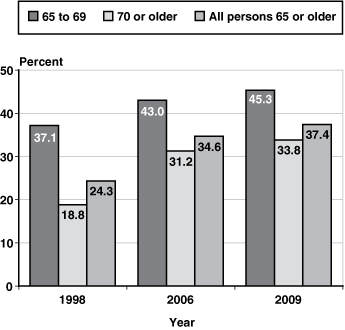
| Year | 65 to 69 | 70 or older | All persons 65 or older |
|---|---|---|---|
| 1998 | 37.1 | 18.8 | 24.3 |
| 2006 | 43.0 | 31.2 | 34.6 |
| 2009 | 45.3 | 33.8 | 37.4 |
The SCF collects detailed financial data, including holdings in different forms of tax-qualified retirement accounts such as IRAs and employer-sponsored DC plans, every 3 years. The SCF also indicates that tax-qualified retirement savings plans increased over time in both prevalence and value.6
SCF data show that the prevalence and value of retirement accounts increased dramatically in the last two decades in younger and older households alike. The prevalence among PEUs headed by a person aged 65 or older increased from about one-fifth in 1992 to about two-fifths in 2007 (Chart 2). The prevalence of tax-qualified retirement accounts is higher among younger households in four of the six periods (Table 5), and the prevalence and value of accounts among PEUs with heads aged 65 or older was higher for those with at least some college education than for those without (Tables 5 and 6).
Percentage of households headed by persons aged 65 or older that have financial assets in retirement savings accounts, selected years 1992–2007
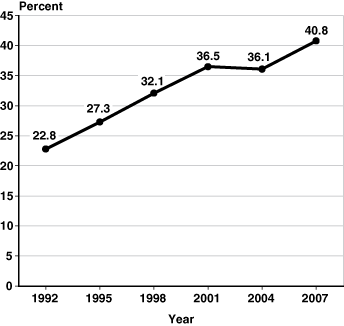
| Year | Percent |
|---|---|
| 1992 | 22.8 |
| 1995 | 27.3 |
| 1998 | 32.1 |
| 2001 | 36.5 |
| 2004 | 36.1 |
| 2007 | 40.8 |
| PEU head characteristic | 1992 | 1995 | 1998 | 2001 | 2004 | 2007 |
|---|---|---|---|---|---|---|
| Age | ||||||
| 45–54 | 51.9 | 57.4 | 59.3 | 63.7 | 58.2 | 65.4 |
| 55–64 | 53.1 | 51.0 | 58.3 | 59.8 | 63.5 | 61.2 |
| 65 or older | 22.8 | 27.3 | 32.1 | 36.5 | 36.1 | 40.8 |
| Education a | ||||||
| High school diploma or less | 16.4 | 19.9 | 22.0 | 23.0 | 26.3 | 29.1 |
| Some college or more | 37.0 | 40.4 | 49.0 | 57.5 | 50.2 | 59.1 |
| SOURCE: SCF. | ||||||
| NOTE: Tax-qualified retirement savings plans include IRAs, Keoghs, and 401(k)-type accounts. All observations are weighted for analysis. | ||||||
| a. Restricted to PEU heads aged 65 or older. | ||||||
| PEU head characteristic a | 1992 | 1995 | 1998 | 2001 | 2004 | 2007 |
|---|---|---|---|---|---|---|
| Age | ||||||
| 45–54 | 40,500 | 37,900 | 44,600 | 56,100 | 61,000 | 63,000 |
| 55–64 | 43,400 | 43,300 | 59,800 | 64,300 | 91,200 | 100,000 |
| 65 or older | 28,900 | 36,500 | 44,600 | 66,700 | 60,400 | 60,800 |
| Education b | ||||||
| High school diploma or less | 23,200 | 24,500 | 31,800 | 32,700 | 32,900 | 35,000 |
| Some college or more | 36,200 | 54,100 | 59,800 | 114,600 | 93,400 | 116,000 |
| SOURCE: SCF. | ||||||
| NOTE: Tax-qualified retirement savings plans include IRAs, Keoghs, and 401(k)-type accounts. All observations are weighted for analysis. Values indexed to 2007 dollars with the CPI-U-RS. | ||||||
| a. Restricted to PEUs with positive asset holding values. | ||||||
| b. Restricted to PEU heads aged 65 or older. | ||||||
Among PEUs headed by persons aged 65 or older, the median real value of retirement accounts more than doubled, from $28,900 to $60,800, over the period from 1992 to 2007 (Table 6 and Chart 3). Table 6 also shows that the 55–64 age group generally has the highest median account balances.
Median value of assets held in retirement savings accounts among households headed by people aged 65 or older
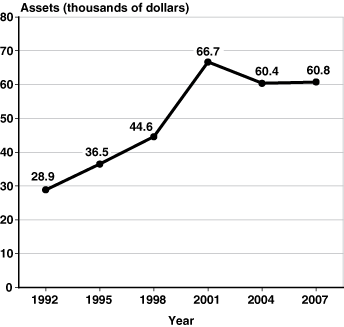
| Year | Assets (thousands of dollars) |
|---|---|
| 1992 | 28.9 |
| 1995 | 36.5 |
| 1998 | 44.6 |
| 2001 | 66.7 |
| 2004 | 60.4 |
| 2007 | 60.8 |
Table 7 shows the proportion of total PEU financial assets that are attributable to tax-qualified retirement account holdings. It reveals that in 2007, larger proportions of financial assets were held in tax-qualified retirement accounts than were held in 1992. The proportion increased more rapidly for PEUs headed by persons aged 65 or older than for those headed by persons aged 45–64. The increases also were strong among PEUs headed by persons with at least some college education.
| PEU head characteristic | 1992 | 1995 | 1998 | 2001 | 2004 | 2007 |
|---|---|---|---|---|---|---|
| Age | ||||||
| 45–54 | 57.8 | 55.1 | 55.2 | 58.7 | 67.2 | 72.4 |
| 55–64 | 46.4 | 44.4 | 52.7 | 45.8 | 64.0 | 66.3 |
| 65 or older | 27.2 | 33.3 | 31.0 | 35.2 | 34.1 | 40.5 |
| Education a | ||||||
| High school diploma or less | 29.6 | 32.3 | 33.1 | 39.2 | 35.3 | 41.6 |
| Some college or more | 21.6 | 33.8 | 29.4 | 30.0 | 33.7 | 40.1 |
| SOURCE: SCF. | ||||||
| NOTE: Tax-qualified retirement savings plans include IRAs, Keoghs, and 401(k)-type accounts. Financial assets include funds held in bank transaction accounts, certificates of deposits, directly held mutual funds, stocks, bonds, retirement plan investment accounts, savings bonds, cash value of whole life insurance, other managed assets, and other financial assets. All observations are weighted for analysis. | ||||||
| a. Restricted to PEU heads aged 65 or older. | ||||||
Income from Pensions
In addition to questions about income from traditional DB pension plans, the SIPP asks respondents whether they took distributions from IRAs or 401(k)-type retirement plans.7 Looking at individual planholders aged 65 or older, almost one-half reported taking a distribution in 1998, and over one-half did so in 2006 (Chart 4). However, by about 10 percentage points, fewer people reported taking a distribution in 2009 than did in 2006. People aged 70 or older are much more likely to have reported distributions from retirement plans than are those aged 65–69. This is due in part to the federal law that requires withdrawals to be taken starting in the year after the account holder reaches age 70½. That law was suspended for 1 year in 2009 to allow retirement accounts to recover from the 2008 stock market crash.
Shares of IRA or 401(k) holders aged 65 or older who take withdrawals: 1998, 2006, and 2009
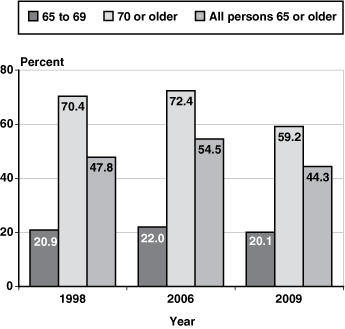
| Year | 65 to 69 | 70 or older | All persons 65 or older |
|---|---|---|---|
| 1998 | 20.9 | 70.4 | 47.8 |
| 2006 | 22.0 | 72.4 | 54.5 |
| 2009 | 20.1 | 59.2 | 44.3 |
Based on the SIPP data, about one-half of persons aged 65 or older reported DB pension income in 2009 (Chart 5). Younger retirees (aged 65–69) have higher DB pension income than older retirees as measured by means or medians (Chart 6). The lower pension income of older retirees reflects both lower lifetime average earnings and the fact that most DB pensions do not provide cost-of-living adjustments.
Percentage of individuals aged 65 or older who have pension income, by plan type: 1998, 2006, and 2009
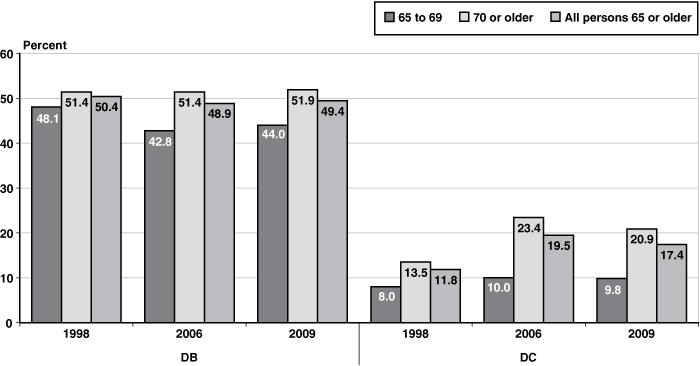
| Year | 65 to 69 | 70 or older | All persons 65 or older |
|---|---|---|---|
| DB | |||
| 1998 | 48.1 | 51.4 | 50.4 |
| 2006 | 42.8 | 51.4 | 48.9 |
| 2009 | 44.0 | 51.9 | 49.4 |
| DC | |||
| 1998 | 8.0 | 13.5 | 11.8 |
| 2006 | 10.0 | 23.4 | 19.5 |
| 2009 | 9.8 | 20.9 | 17.4 |
Mean and median annual DB pension income among people aged 65 or older with a DB pension: 1998, 2006, and 2009
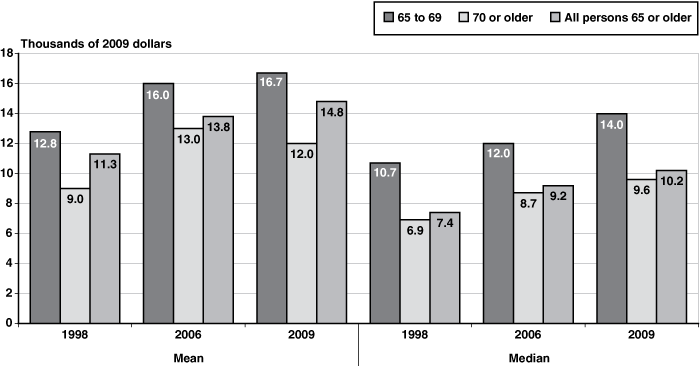
| Year | 65 to 69 | 70 or older | All persons 65 or older |
|---|---|---|---|
| Mean | |||
| 1998 | 12.8 | 9.0 | 11.3 |
| 2006 | 16.0 | 13.0 | 13.8 |
| 2009 | 16.7 | 12.0 | 14.8 |
| Median | |||
| 1998 | 10.7 | 6.9 | 7.4 |
| 2006 | 12.0 | 8.7 | 9.2 |
| 2009 | 14.0 | 9.6 | 10.2 |
Despite the shift from traditional DB pensions to DC plans over the past 30 years, income among the aged from traditional DB pensions is still much more prevalent and much higher than income from DC plans and IRAs. The proportion of people aged 65 or older with distributions from DC plans and IRAs increased from about one-tenth in 1998 to almost one-fifth in 2006 (Chart 5). The proportion then declined slightly, to about 17 percent in 2009. Distributions were more prevalent among those aged 70 or older, and the prevalence declined slightly from 2006 to 2009. At both the mean and median levels, income from DB plans (Chart 6) exceeds distributions from DC retirement savings plans (Chart 7). Future retirees can have higher income from DC plans than current retirees because they will have participated in DC plans for more years than current retirees.
Mean and median annual DC pension income of people aged 65 or older with an IRA or 401(k): 1998, 2006, and 2009
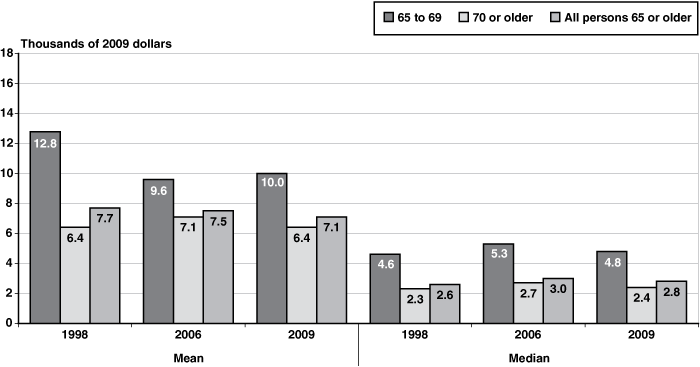
| Year | 65 to 69 | 70 or older | All persons 65 or older |
|---|---|---|---|
| Mean | |||
| 1998 | 12.8 | 6.4 | 7.7 |
| 2006 | 9.6 | 7.1 | 7.5 |
| 2009 | 10.0 | 6.4 | 7.1 |
| Median | |||
| 1998 | 4.6 | 2.3 | 2.6 |
| 2006 | 5.3 | 2.7 | 3.0 |
| 2009 | 4.8 | 2.4 | 2.8 |
The data suggest that retirement savings plans such as 401(k)-type DC plans and IRAs have increased in importance among the aged over the past two decades as an asset holding and as an income source. The pattern among current full-time workers in 2009 indicates that retirement accounts will have increasing importance among future retirees, and likely will be the predominant retirement income source within a couple of decades.
Conclusion
The data presented in this article show that the tax-qualified retirement savings plan is the predominant plan among workers in the early 21st century. Both the prevalence and value of these accounts have risen dramatically in the past 20 years. The shift toward greater distributions from DC plans and IRAs raises important questions about the accuracy of the CPS measures of the number of households that take such distributions and the proportion of household income derived from such accounts. As Sabelhaus and Schrass (2009, 19) wrote of the CPS: "while IRA withdrawals have risen in importance as a source of retirement income, the most widely cited income measure has failed to capture that growth. Looking ahead, that trend is likely to continue." That measurement gap applies to money withdrawn from all tax-qualified retirement savings plans, not just IRAs. The major nationally representative surveys of household income must accurately measure annual distributions from retirement accounts in order to provide a complete picture of the economic well-being of the aged and the general US population. That may require the survey questions to be revised to inquire more directly about distributions from retirement accounts, whether taken as lump sums, regular distributions, or irregular periodic withdrawals.
Notes
1 See Holzmann and Hinz (2005) for a discussion of a multipillar approach to old-age income security.
2 Qualified distributions from Roth IRAs are not taxable because the contributions were taxed in the year they were made. About 40 percent of households with an IRA have a Roth IRA, but Roth IRAs hold only about 5 percent of all IRA assets (Holden and Schrass 2011).
3 However, the CPS underreported pension income even when most pensioners participated in traditional DB plans.
4 The SIPP data on type of pension are from the Retirement and Pension Plan topical module (the third wave) in the 2008 panel. We adjust the SIPP survey results with data on deferred contributions in SSA earnings records. SSA and Census Bureau linked the earnings data derived from W-2 payroll tax records for about 90 percent of the SIPP respondents. Prior research has found that SIPP respondents tend to underreport DC plan participation, as indicated by positive deferred contributions in their earnings records (Dushi and Iams 2010).
5 Workers whose 2008 Form W-2 recorded earnings above $56,376 were in the top quartile. Workers with earnings less than or equal to $20,946 were in the lowest earnings quartile. Median earned income in 2008 was $35,705.
6 We index the values with the Consumer Price Index for All Urban Consumers (CPI-U-RS); see Bucks and others (2009, Table A.1). The SCF is conducted with the cooperation of the Statistics of Income Division of the Internal Revenue Service. It includes data on household assets and debts, use of financial services, income, demographics, and labor force participation.
7 The SIPP core asks about all sources of income in the previous 4-month reference period. Merging the core files for three consecutive waves of the survey provides a picture of income sources and amounts over a full year.
References
BLS. See Bureau of Labor Statistics.
Bosworth, Barry P., Gary Burtless, and Sarah E. Anders. 2007. "Capital Income Flows and the Relative Well-Being of America's Aged Population." CRRB Working Paper No. 2007-21. Cambridge, MA: Center for Retirement Research at Boston College.
Brown, Jeffrey R., Jeffrey R. Kling, Sendhil Mullainathan, and Marian V. Wrobel. 2008. "Why Don't People Insure Late Life Consumption? A Framing Explanation of the Under-Annuitization Puzzle." American Economic Review 98(2): 304–309.
Bryant, Victoria L., Sarah Holden, and John Sabelhaus. 2011. "Qualified Retirement Plans: Analysis of Distribution and Rollover Activity." Pension Research Council Working Paper No. 2011-01. Philadelphia, PA: Pension Research Council.
Bucks, Brian, Arthur Kennickell, Traci Mach, and Kevin Moore. 2009. "Changes in U.S. Family Finances from 2004 to 2007: Evidence from the Survey of Consumer Finances." Federal Reserve Bulletin 95(2): A1–A56.
Bureau of Labor Statistics. 2009. National Compensation Survey: Employee Benefits in the United States, March 2009. Bulletin 2731. Washington, DC: BLS. http://www.bls.gov/ncs/ebs/benefits/2009/.
———. 2010. National Compensation Survey: Employee Benefits in the United States, March 2010. Bulletin 2752. Washington, DC: BLS. http://www.bls.gov/ncs/ebs/benefits/2010/home.htm.
Cagetti, Marco, and Mariacristina De Nardi. 2008. "Wealth Inequality: Data and Models." Macroeconomic Dynamics 12 (S2): 285–313.
Czajka, John L., and Gabrielle Denmead. 2011. "What We're Missing: How to Obtain Better Estimates of the Retirement Income of Our Major Household Surveys." Paper presented to the 2011 Association of Policy Analysis and Applied Management, Washington, DC.
Dushi, Irena, and Howard M. Iams. 2010. "The Impact of Response Error on Participation Rates and Contributions to Defined Contribution Pension Plans." Social Security Bulletin 70(1): 45–61. http://www.socialsecurity.gov/policy/docs/ssb/v70n1/v70n1p45.html.
Dushi, Irena, Howard M. Iams, and Christopher R. Tamborini. 2011. "Defined Contribution Pension Participation and Contributions by Earnings Levels Using Administrative Data." Social Security Bulletin 71(2): 67–76. http://www.socialsecurity.gov/policy/docs/ssb/v71n2/v71n2p67.html.
Federal Interagency Forum on Aging Related Statistics. 2012. Older Americans 2012: Key Indicators of Well-Being 2012. Washington, DC: Government Printing Office. http://www.agingstats.gov/agingstatsdotnet/Main_Site/Data/Data_2012.aspx.
Federal Retirement Thrift Investment Board. 2012. "Thrift Savings Fund Statistics." Fairfax, VA: FRTIB. http://www.frtib.gov/pdf/minutes/MM-2012Jan-Att1.pdf.
Holden, Sarah, and Daniel Schrass. 2010. "The Role of IRAs in U.S. Households' Saving for Retirement, 2010." Research Fundamentals 19(8). http://www.ici.org/pdf/fm-v19n8.pdf.
———. 2011. "The Role of IRAs in U.S. Households' Saving for Retirement, 2011." ICI Research Perspective 17(8). http://www.ici.org/pdf/per17-08.pdf.
Holzmann, Robert, and Richard Hinz. 2005. Old-Age Income Support in the 21st Century: An International Perspective on Pension Systems and Reform. Washington, DC: The World Bank.
Investment Company Institute. 2012. "The U.S. Retirement Market, Third Quarter 2011." http://www.ici.org/info/ret_11_q3_data.xls.
Meijer, Erik, Lynn A. Karoly, and Pierre-Carl Michaud. 2010. "Using Matched Survey and Administrative Data to Estimate Eligibility for the Medicare Part D Low-Income Subsidy Program." Social Security Bulletin 70(2): 63–82. http://www.socialsecurity.gov/policy/docs/ssb/v70n2/v70n2p63.html.
Roemer, Marc I. 2000. "Assessing the Quality of the March Current Population Survey and the Survey of Income and Program Participation Income Estimates, 1990–1996." Washington, DC: Census Bureau. http://www.census.gov/hhes/www/income/publications/assess1.pdf.
Sabelhaus, John, and Daniel Schrass. 2009. "The Evolving Role of IRAs in U.S. Retirement Planning." ICI Research Perspective 15(3). http://www.ici.org/pdf/per15-03.pdf.
Schieber, Sylvester J. 1995. "Why Do Pension Benefits Seem So Small?" Benefits Quarterly 11(4): 57–70.
[SSA] Social Security Administration. 2012. Income of the Population 55 or Older, 2010. Washington, DC: SSA. http://www.socialsecurity.gov/policy/docs/statcomps/income_pop55/index.html.
Woods, John R. 1996. "Pension Benefits Among the Aged: Conflicting Measures, Unequal Distributions." Social Security Bulletin 59(3): 3–30. http://www.socialsecurity.gov/policy/docs/ssb/v59n3/v59n3p3.pdf.